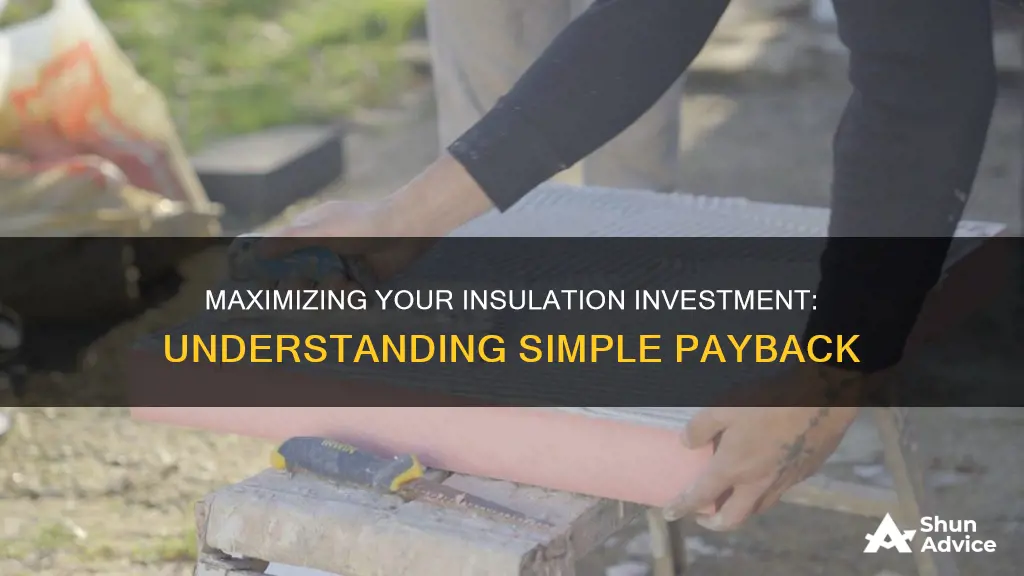
Investing in insulation for your home can be a great way to save money on energy costs and reduce your carbon footprint. The payback period for insulation upgrades refers to the amount of time it takes for the savings on energy bills to equal the cost of the insulation. This can vary depending on several factors, including the type and thickness of insulation, the cost of energy, and the efficiency of the heating system.
There are simple calculations that can help you estimate the payback period for your insulation investment. By taking into account factors such as the cost of insulation, installation costs, energy prices, and the amount of energy saved, you can determine the payback period in years.
| Characteristics | Values |
|---|---|
| What is a simple payback? | The time it takes to recover the additional cost of insulation through savings on fuel usage |
| How to calculate simple payback | Initial investment divided by annual savings after taxes |
| Factors to consider | Type of insulation, cost of insulation, installation cost, price of energy, amount of energy saved, government-compiled averages (e.g. average number of heating days per year in your region), and other factors specific to your home |
| Benefits of insulation | Reduced energy waste and costs, less system maintenance, better energy efficiency, increased home comfort and safety, and a positive return on investment |
What You'll Learn

Calculating the simple payback period
First, you need to determine the current type of insulation and its thickness or amount in the walls or attic. Next, you need to estimate the square footage of the space to be upgraded. Then, find a copy of your utility bill to determine the cost per unit, and gather a quote from your contractor for the work, or research the cost of the necessary materials and installation equipment if you plan to do the work yourself.
Once you have this information, you can use the following formula to calculate the simple payback period:
Simple Payback Period = Initial Investment / Annual Savings After Taxes
The initial investment refers to the cost of the insulation upgrade, including any labour, equipment, and materials. The annual savings after taxes are the amount of money you will save each year on your energy bills due to the improved insulation.
For example, let's say you are planning to upgrade the insulation in your attic to reduce heat loss. You currently have no insulation in your attic, and you want to add R-30 insulation. The space to be upgraded is 1,000 square feet, and the cost of the insulation, including labour, is $3,000. Your current annual heating cost is $2,000, and you estimate that with the new insulation, your annual heating cost will be $1,200.
Using the formula, the simple payback period would be:
Simple Payback Period = $3,000 / ($2,000 - $1,200) = 2.5 years
So, it would take approximately 2.5 years to recoup the cost of the insulation upgrade through the savings on your energy bills.
It is important to note that this calculation assumes a constant cost of energy and does not take into account factors such as air leakage or fluctuations in energy costs. For a more accurate estimation, you may need to consider additional factors and use a more complex formula.
Investing in Others: A Worthy Bet
You may want to see also

ROI and insulation
Insulation is a great way to improve your home's energy efficiency and reduce heating and cooling costs. Adding or upgrading insulation can lead to significant cost savings in the long term, resulting in a positive return on investment (ROI).
The payback period for insulation upgrades varies depending on several factors, including the type and amount of insulation, the climate, and the initial insulation status of the house. According to some sources, attic insulation can pay for itself in a matter of months, while others estimate a payback period of about two years for attic and wall insulation.
To calculate the simple payback period for insulation, you can use the formula: Simple Payback = Initial Investment / Annual Savings After Taxes. The initial investment includes the cost of insulation per square foot, labour, equipment, and a vapour barrier if needed. The annual savings are calculated by considering the reduction in heating or cooling costs due to improved insulation.
It is worth noting that the U.S. Department of Energy provides a calculator to estimate the payback period for insulation upgrades. This calculator takes into account various factors, such as the average number of heating days in your region and the energy efficiency of insulation products. However, it may not account for all factors specific to your home, so it is essential to consider other variables that can impact the payback period.
Additionally, it is important to remember that insulation standards have changed in recent years, with cities and towns raising the required R-Value for insulation. R-Value refers to the capacity of insulation to resist heat flow. Upgrading your insulation to meet these new standards can improve your home's energy efficiency and lead to cost savings.
In summary, upgrading or adding insulation to your home can provide a positive ROI by reducing energy costs. The payback period will depend on various factors, and it is essential to consider all relevant variables when calculating the expected payback.
Funding Strategies for Your Investment Property Empire
You may want to see also

Insulation and energy efficiency
Insulation is an important aspect of energy efficiency in homes. It provides resistance to heat flow, helping to keep a home warm in winter and cool in summer. This resistance is measured by the insulating material's R-value, which indicates its effectiveness in reducing heat flow. The higher the R-value, the better the insulation.
Most homes in the United States are under-insulated, and sealing air leaks and adding insulation are cost-effective ways to improve energy efficiency and comfort. By doing so, homeowners can save up to 15% on heating and cooling costs, or 11% on total energy costs. This equates to significant savings on annual energy bills, with some sources estimating an average of 10% savings.
The payback period for insulation upgrades depends on various factors, including the type and amount of existing insulation, the cost of energy, the efficiency of the heating system, and the local climate. The simple payback calculation is the initial investment divided by the annual savings after taxes. There are also online calculators available that can help estimate the payback period, taking into account factors such as the average number of heating days in a region and the energy efficiency of insulation products.
When considering insulation upgrades, it is important to address air leakage, as this can significantly impact the effectiveness of the insulation. The type of insulation, its thickness, and its density also play a role in determining the overall R-value and, consequently, the energy savings achieved.
Recession-Proof Investments: Strategies for Success
You may want to see also

Insulation types and their payback
The payback period for insulation investments is the time it takes for the money saved on reduced fuel usage to recover the cost of the insulation. This period varies depending on the type of insulation, the thickness, the area covered, and the cost of energy.
The most common types of insulation materials include:
- Fiberglass: the most common insulation material, made from fine glass fibers, and often used in batts, rolls, and loose-fill insulation.
- Cellulose: made from recycled paper products and usually a loose-fill insulation.
- Foam: made from polystyrene, polyisocyanurate, or polyurethane, and can be sprayed or installed in rigid foamboards.
- Mineral wool: rock wool or slag wool, both fire-resistant, and available in batts, rolls, and loose-fill.
- Natural fibers: materials such as cotton, sheep's wool, straw, and hemp, usually from recycled sources and treated to be resistant to fire, mold, and insects.
- Denim: made from recycled jeans and non-toxic, making it easy for DIY installation.
The payback period for these insulation types will vary based on several factors. For example, the payback period for external wall insulation will depend on the type of insulation chosen. Mineral wool, a premier solution, may have a different payback period compared to EPS, which is the most popular and offers excellent value for money.
Additionally, the payback period is influenced by the initial R-value of the wall or insulation, the final R-value after improvement, the cost of insulation per square foot, the cost of energy, and the efficiency of the heating system.
While the payback period may seem long, the benefits of improved insulation include reduced heat loss, lower fuel usage, decreased energy bills, and a more comfortable indoor temperature.
Retirement Investments: Safe Options for the Elderly
You may want to see also

The initial outlay and long-term benefits
The initial outlay for insulation may seem expensive, but the long-term benefits are significant. The first step in calculating the payback period of an insulation investment is to determine the cost of the insulation and its installation. This includes the cost of the insulation material itself, as well as any labour and equipment costs associated with the installation process.
The next step is to consider the price of energy in your home and the amount of energy that will be saved by installing energy-efficient insulation. This can be calculated by finding the difference between your old and new heating bills. The payback period is then calculated by dividing the initial cost of the insulation by the annual savings. The shorter the payback period, the quicker the investment can be paid off, and the homeowner can start making savings.
It is important to note that the payback period of external wall insulation will depend on the type of insulation chosen. More expensive insulation does not always result in a longer payback period, as some types of insulation offer greater benefits at a lower thickness. For example, Mineral Wool insulation is completely non-combustible and can withstand temperatures of up to 1000°C, while K5 Kingspan insulation is a space-saving solution that is ideal for narrow passageways.
In addition to the financial savings, there are other long-term benefits to investing in insulation. Firstly, insulation can help to reduce the strain on your HVAC system, leading to reduced maintenance costs and a lower risk of damage or breakdown. Secondly, up-to-date insulation and air sealing will improve your home's energy efficiency, resulting in a reduced carbon footprint. Finally, effective insulation can increase the value of your property, as a well-insulated home will be more comfortable and energy-efficient.
The IT Investment Equation: Unraveling the ROI Riddle
You may want to see also
Frequently asked questions
To calculate the payback period of your insulation investment, you need to consider the following factors:
- The cost of the insulation material and its installation.
- The price of energy in your home.
- The amount of energy you will save with the new insulation.
- The type of insulation you choose to install.
To calculate the payback period, you can use the following formula: First Cost / Annual Savings = Payback Period. First Cost refers to the cost of new insulation minus the cost of old insulation, and Annual Savings is calculated by subtracting the cost of your new heating bill from your old one.
Yes, there are online payback calculators available, such as the one provided by Fine Homebuilding, which is based on an equation from the U.S. Department of Energy. You can input details such as your current type of insulation, the square footage of the area to be upgraded, your cost per unit of energy, and the quote from your contractor to estimate the payback period.
Upgrading your insulation can provide several benefits, including reduced energy waste and costs, less maintenance for your HVAC system, and improved energy efficiency in your home, leading to a reduced carbon footprint. Additionally, improving the insulation in your home can increase comfort by maintaining a more consistent temperature throughout the space.







